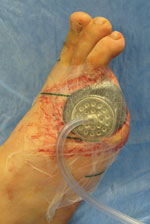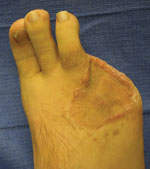Increased graft survival in foot and ankle surgery aided by negative pressure wound therapy
Click Here to Manage Email Alerts
When used in conjunction with reticulated open cell foam, negative pressure wound therapy significantly increases split-thickness skin graft survival in foot and ankle reconstructive surgeries compared to conventional therapy, according to a study published in the International Wound Journal.
“Negative pressure therapy is truly a perioperative adjunct and has now been proven to replace any stenting of skin grafts, and therefore reduces the rate of failure and increases the rate of a take of a split-thickness skin graft in foot and ankle reconstruction,” Peter A. Blume, DPM, FACFAS, told Orthopedics Today.
NPWT vs. conventional therapy
In a 10-year retrospective review, Blume and colleagues studied 142 patients to determine whether negative pressure wound therapy (NPWT) and reticulated open cell foam delivered via vacuum-assisted closure (VAC) therapy (KCI; San Antonio) affected the survival of foot and ankle skin grafts. A reticulated open cell foam conventional therapy, in which surgeons packed Xeroform (Coviden; Mansfield, Mass.) dressings or cotton balls on top of the graft and a created a stent, was used as a control.
In addition to analyzing overall graft take, researchers looked at demographic data, wound etiology, dressing type, duration of NPWT, outpatient treatments and surgery complications to determine the efficacy of NPWT for preventing complications.
The investigators found that the NPWT group had a 3% to 5% revision rate for grafts compared to the control group, which had a rate of 16%. In cases where safety was examined, the NPWT group also had fewer cases of graft failure due to seroma, hematoma and infection than the control group.
|
|
|
|
|
Images: Blume PA |
An adjunct therapy
Blume said, in general, most surgeons use NPWT instead of conventional treatment as a form of adjunct therapy.
“[Conventional treatments] lose their compression after a few hours based on the elasticity of the tissue and therefore negative pressure therapy never loses its compression on these skin grafts,” he said. “It has altered the algorithmic approach towards skin grafting foot and ankle wounds.”
The next step in research is a NPWT system where topical antibiotics are placed directly into the wound to disinfect it, Blume said. – by Jeff Craven
Reference:
- Blume PA, Key JJ, Thakor P, et al. Retrospective evaluation of clinical outcomes in subjects with split-thickness skin graft: Comparing V.A.C. therapy and conventional therapy in foot and ankle reconstructive surgeries. Int Wound J. 2010; 7:480-487.

- Peter A. Blume, DPM, FACFAS, can be reached at the Department of Anesthesiology and the Department of Orthopedics and Rehabilitation, Yale School of Medicine, New Haven, Conn; 203-397-0624; email: peter.b@snet.net.
- Disclosure: The authors received devices from KCI; Blume is a consultant for KCI.




